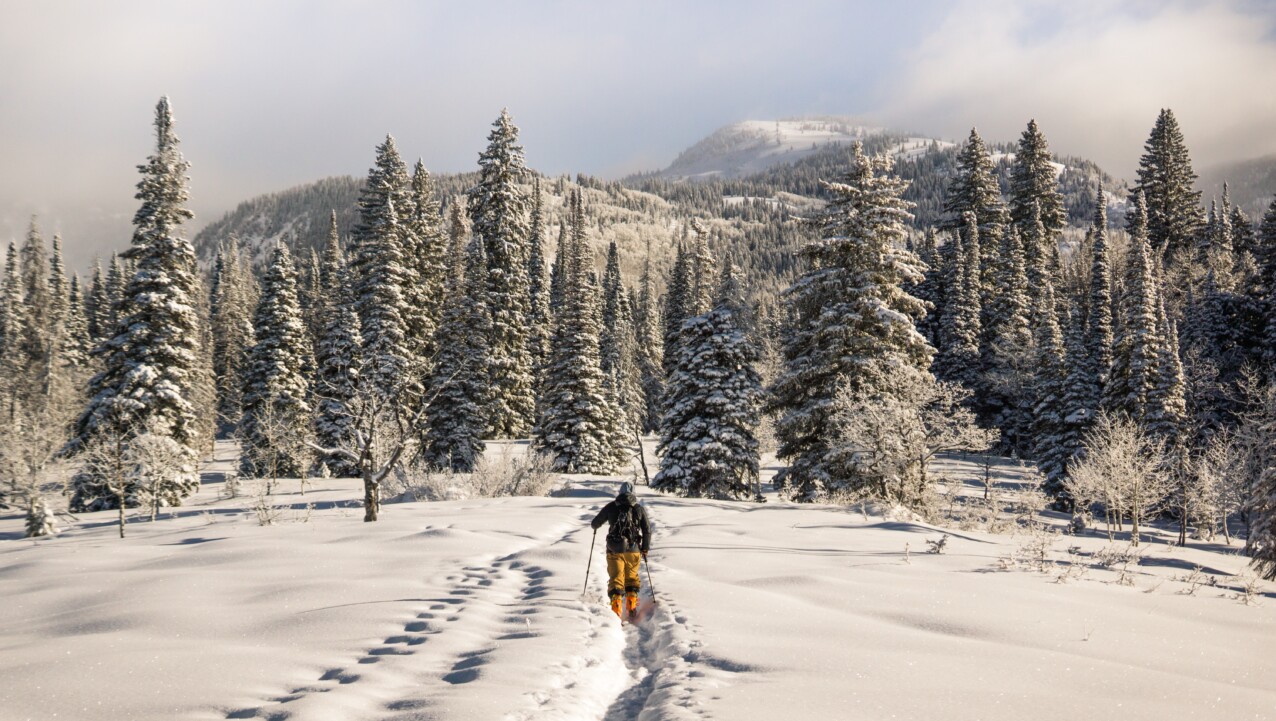January 20, 2023
Water in the West is a cyclical process that flows through the seasons – snow blankets the mountains in the winter and early spring, then melts and runs off into rivers and lakes, and helps to fill our reservoirs through the late spring and summer months that eventually flow into our homes across the West. Come fall, the process begins anew. In the Colorado River Basin and areas that receive Colorado River water, this process provides drinking water to upwards of 40 million users across seven US states and northern Mexico. A natural cycle of creating and distributing water across the West, “snowpack” refers to the amount of snow that accumulates in the mountains throughout the winter and early spring months.
While snowpack can naturally vary quite significantly from year to year, overall, climate change is negatively impacting this resource in multiple ways. More precipitation is falling as rain rather than snow, peak snowmelt and the timing of runoff has shifted earlier in the year, and how much of that snowmelt ends up in the rivers (also known as “runoff efficiency”) has decreased, all contributing to declining water levels in our streams, rivers, and reservoirs.
While we might think of snowpack as the purview of winter recreationists, snowpack is a critical element of the water cycle in the West. Mountain snowpack stores water in the winter and when it melts that water runs off into rivers and lakes, eventually reaching reservoirs which help provide hydropower, irrigation, and drinking water. Some of that water ends up soaking into the ground becoming groundwater.
According to the EPA, snowpack in most Western river basins is a larger source of water storage than human-built reservoirs. Snowpack is essential to creating healthy flowing rivers that support ecosystems and habitat for thousands of species, recreation, and tourism. Much of the recreation and agriculture that sustains economies throughout our region depend on healthy river flows, a steady and reliable snowpack, and predictable run off.
Communities also rely on the snowpack to fill reservoirs that supply cities and towns with a steady supply of drinking water year-round. As we see some of our major reservoirs drop to unprecedented levels, we depend on precipitation to fill them up and continue to provide water to our cities and towns. A good snowpack also ensures high soil moisture. This increases how much snowmelt makes it to the rivers (again, that “runoff efficiency”), helps safeguard against wildfire conditions, and supports ecosystems for wildlife and plant species. Earlier snowmelt can mean a more challenging wildfire season. Even certain trees and animal species rely on snow as insulation and changes in snowpack and melt can affect fish spawning.
Our Changing Snowpack: Snowpack and Climate Change
In a 2018 study in NPJ Climate and Atmospheric science, the authors reported that “since 1915, the average snowpack in western states has declined by between 15 and 30 percent …. and the amount of water lost from that snowpack reduction is comparable in volume to Lake Mead, the West’s largest manmade reservoir.”
A warming climate means that more precipitation will fall as rain, rather than snow, which reduces the snowpack. Warming temperatures are also affecting the seasonality of our snow. Spring temperatures arriving earlier and freezing winter temperatures arriving later – means that the reliability of our snowpack and timing of runoff are impacted. Shorter winters means less snowpack, which results in less water in our rivers and reservoirs and earlier, quicker runoff that can cause reduced soil moisture overall.
Western states naturally receive significantly less precipitation than the eastern half of the U.S. – dividing roughly at the 100th meridian – and changes in the amount or type of precipitation the West receives in any one year impacts drought conditions throughout the region. This is especially important considering the drought conditions faced in the west over the past several decades. Droughts can have serious impacts on fish and wildlife, recreation-based economies, farmers and ranchers and may even affect your household outdoor water use if summer-time water use restrictions are put in place by your water provider.
Droughts are a good indicator of trends in water scarcity in the West. Climate change is causing more severe drought conditions in the West, and it is highly unlikely things will go back to “normal.” The National Drought Mitigation Center maps identify “general areas of drought and labels them by intensity. D1 is the least intense level and D4 the most intense. Drought is defined as a moisture deficit bad enough to have social, environmental or economic effects.”
Will an above-average snowfall year change things?
We can’t help but get excited when we have a great snowpack year. Ski resorts stay open longer, whitewater sports get an economic boost, and farmers can hope for a long and steady runoff season. But big snowpack years have been fewer and farther between. When we do see an above average year for snowpack in the West, it can be hard to keep the bigger picture in mind. Since 1987, snowpack in the Colorado River Basin has rarely been above the 50-year average more than two consecutive years in a row. Unfortunately, one or two good snow years aren’t going to be enough refill our reservoirs, improve soil moisture, and ensure our rivers have healthy flows. That would take five or six good years, in a row, and as discussed before these good years are becoming less common.
Rising temperatures in the West are changing the type of precipitation we receive during the winter months. We are receiving more precipitation as rain instead of snow, which runs off fast and is hard to store for use in the summer, and higher temperatures lead to greater evaporation too. Snowpack acts as a “reservoir” in that it stores water in the winter and spring, only releasing it when melting later in the year. When that precipitation falls as rain, it’s not held in that snowpack “reservoir”. These changes will only grow in severity as the climate continues to change. It’s best to think of this long-term drying of the West as “aridification”, rather than a drought that will “end” with temperatures and precipitation going back to “normal” at some time in the future.
Understanding Your Snowpack in Real Time
One of the best things that people can do in the face of the water crisis is to learn more about where their water comes from. Individuals, in real time, can track the snowpack throughout the winter and see what those levels mean for the spring’s runoff and river flows, as well as impacts to Lake Powell and other reservoirs. Learning about the interconnected water cycle across the West and the impacts of snowpack and spring runoff can give communities a better understanding of the impacts of climate change in their communities.
There are several resources you can use to see the impacts of snowpack, run off, and drought.
You can monitor how current snowpack will impact streamflow later in the year by measuring Snow Water Equivalent (SWE). SWE (pronounced ‘swee’) is the amount of water contained within the snowpack. You can think of it as how much water there would be if the entire snowpack were to melt.
The EPA’s Snowpack Data Explorer provides snowpack and precipitation data for watersheds in the Western United States and compares the baseline (historical data from 1982-2005) and future (model projections for 2070-2099) time periods. For example, in the Colorado Headwaters Watershed, models project that the future peak SWE may be 84% of the baseline peak and could occur 25 days earlier.
The Colorado River Basin Forecast Center provides hundreds of “snow groups”, which are a collection of SNOTEL sites in various watersheds and drainages. These measure SWE and provide a percentage of median. If you want to get a good idea of the status of snowpack for the Colorado River Basin, try clicking on the “Lake Powell 17 Snotel Group” — but be patient, these graphs can sometimes be slow to load.
USGS Water Watch uses stream gages to monitor streamflow throughout the year. Their maps show the percentile classes of daily streamflow compared to historic streamflow for each watershed.
The Intermountain West Climate Dashboard from Western Water Assessment provides situational awareness of climate, drought, and water resources for Colorado, Utah, and Wyoming.
It’s Not Just Drought and Climate Change, Policy Matters: WRA’s Solutions
While shrinking snowpack and changes in precipitation may seem like just a weather or hydrological issue, it’s also a policy issue. We see the impacts of climate change and know those challenges are growing and most likely will continue through the rest of the century. But we don’t have to be at the whims of good or bad winters for our snowpack and water supply. We can put smart policies in place that don’t leave our water supply up to chance. A good snow year won’t fix the problem, but good policy will. For the sustainability of the Colorado River Basin, it’s critical that we continue to implement good water conservation policies, like improving agricultural efficiency, integrating municipalities’ water and land use planning, re-using or recycling water, transforming our outdoor landscapes (I.e., turf replacement), improving indoor water efficiency, and many other ways to simply use less water overall. .
The healthiest flowing rivers in the West have one thing in common: a robust streamflow sufficient to meet all of the diverse uses of rivers. Flowing rivers sustain wetlands, provide habitat for native fish and wildlife, offer recreational opportunities for outdoor enthusiasts, water our crops, and supply drinking water. Our communities need all these healthy river benefits to survive and thrive. For these rivers to stay healthy, we need a good snowpack, along with myriad of other climate solutions that ensure that we avoid the worst impacts of the climate crisis, that we’re prepared for low snow years with sensible water conversation policies, and that our wildlife and habitats that depend on this water are protected too.



